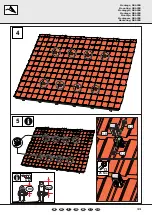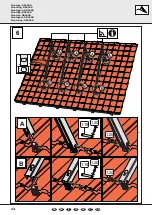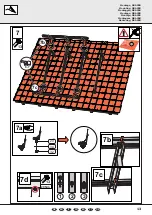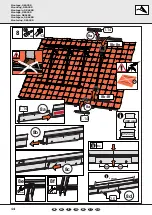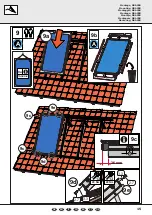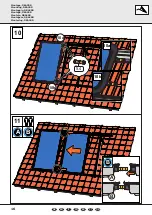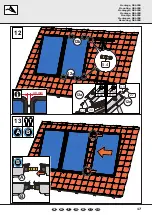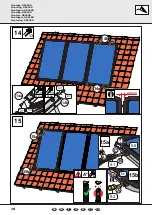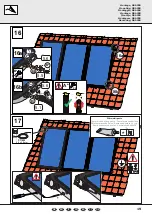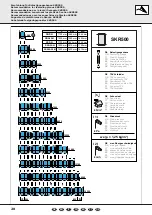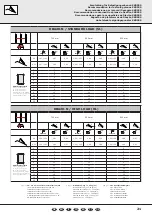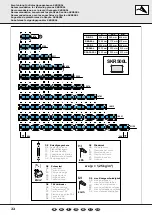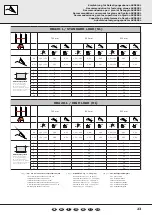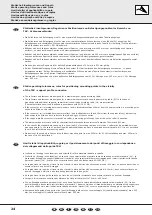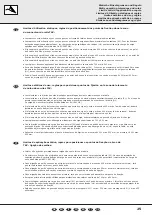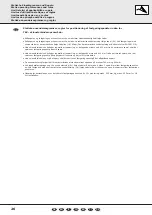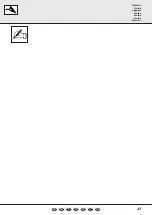
24
DE
EN
IT
FR
ES
PT
DK
DE
Statische Einsatzgrenzen, Regeln zum Positionieren von Befestigungspunkten im Bereich von
TSV - Schienenverbinder:
●
Die Kollektoren und Befestigung sind für eine maximale Böengeschwindigkeit von siehe Tabelle ausgelegt .
● Die Kollektoren und Befestigung sind für eine max. charakteristische Schneelast von siehe Tabelle (SL) ausgelegt. Bei
Befestigungen mit zusätzlichen Stützen sind charakteristische Schneelasten bis siehe Tabelle (HL) zulässig (Die charakteristi-
sche Schneelast ist nach EN 1991 NA defi niert).
● Befi ndet sich der Schienenverbinder zwischen zwei Sparren (und ist weniger als 400 mm vom nächstgelegenen Sparren
entfernt), so muss auf diesem Sparren ein Befestigungspunkt gesetzt werden.
● Befi ndet sich der Schienenverbinder zwischen zwei Sparren (und ist mehr als 400 mm vom nächstgelegenen Sparren entfernt)
so muss auf beiden Sparren links und rechts vom Verbinder ein Befestigungspunkt gesetzt werden .
● Befi ndet sich der Schienenverbinder auf einen Sparren, so muss auf dem betroffenen Sparren ein Befestigungspunkt gesetzt
werden .
●
Die oben genannten Regeln sind für übliche Sparrenabstände von 700 mm bis 900 mm gültig .
● Bei der Standardbefestigung bis siehe Tabelle Schneelast (SL) darf zwischen den Befestigungspunkten max. 1 Sparren
freigelassen werden. Bei der Befestigung mit zusätzlichen Stützen bis siehe Tabelle Schneelast (HL) darf zwischen den
Befestigungspunkten kein Sparren freigelassen werden .
●
Überstand der Trageschiene über den äußersten Befestigungspunkt bei SL N/L Montage max . 525 mm, bei HL N/L Montage
max . 425 mm .
EN
Static operating tolerances, rules for positioning mounting points in the vicinity
of the TSV - support profi le connector:
●
The collectors and fastener are designed for a maximum gust speed according table .
● The collectors and fastener are designed for a maximum characteristic snow load according table.(SL) In the case of
mountings with additional supports, characteristic snow loads according table (HL) are permissible.
(The characteristic snow load is defi ned in accordance with EN 1991 NA).
● If the connector rail is located between two spars (and is situated less than 400mm from the nearest rafter), a mounting point
needs to be fi tted on this rafter.
● If the connector rail is located between two rafters (and is situated more than 400mm from the nearest rafter), a mounting
point needs to be fi tted on both rafters to the left and right of the connector.
● If the support profi le connector is located on a rafter, a mounting point needs to be fi tted on the rafter in question.
●
The aforementioned rules are valid for characteristic distances between rafters of between 700mm and 900mm .
● In the case of the standard mounting up to a snow load (SL) according table no more than 1 rafter may be omitted between
mounting points. In the case of a mounting with additional supports up to a snow load according table (HL) it is not permitted
to omit any rafter between mounting points .
●
Protrusion of the support rail beyond the furthest mounting point is max . 525mm for SL N/L installation and max . 425mm in
the case of HL N/L installation .
IT
Limiti statici di applicabilità, regole per il posizionamento dei punti di fi ssaggio in corrispondenza
dei collegamenti delle guide TSV:
● I collettori e i fi ssaggi sono ideati per una velocità di raffi ca massima indicata in tabella.
● I collettori e i fi ssaggi sono ideati per un carico di neve caratteristico massimo come da tabella per carichi standard (SL). In
presenza di fi ssaggi con supporti addizionali i carichi di neve caratteristici ammessi raggiungono i valori riportati nella tabella
per carichi elevati (HL) (il carico di neve caratteristico è defi nito dalla norma EN 1991 NA).
● Se la giunzione tra le guide si trova fra due travetti (e dista dal travetto successivo meno di 400 mm), su questo travetto deve
essere collocato un punto di fi ssaggio.
● Se la giunzione tra le guide si trova fra due travetti (e dista dal travetto successivo più di 400 mm), deve essere collocato un
punto di fi ssaggio a sinistra e a destra della giunzione tra le due guide.
● Se la giunzione tra due guide cade su un travetto, sul travetto interessato deve essere collocato un punto di fi ssaggio.
●
Le regole di cui sopra sono valide per distanze fra travetti comprese fra 700 mm e 900 mm .
● Con un fi ssaggio standard perun carico di neve fi no al pertinente valore indicato dalla tabella carichi standard (SL), fra due
punti di fi ssaggio deve essere lasciato libero al massimo 1 travetto. Nel caso si intenda realizzare un sistema atto a sopportare
un carico neve fi no ai valori indicati nella tabella per carichi elevati (HL), occorre posizionare un fi ssaggio su ogni travetto.
● Sporgenza della guida di supporto oltre i punti di fi ssaggio più esterni: con montaggio SL (tabella carichi standard) max. 525
mm, con montaggio HL (tabella carichi elevati) max. 425 mm.
Statische Einsatzgrenzen und Regeln
Static operating tolerances and rules
Limiti statici di applicabilità e regole
Limites d‘utilisation statiques et règles
Límites estáticos de uso y reglas
Limites de aplicação estática e regras
Statiske anvendelsesgrænser og regler
Содержание SKR500 DBA20R
Страница 27: ...27 Notizen Notes Appunti Notes Notas Notas Notizen DE EN IT FR ES PT DK...
Страница 28: ...www sonnenkraft com...


